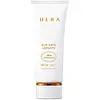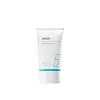Hera Sun Mate Leports Pro Waterproof SPF 50+ PA++++ Versus Missha All Round Safe Block Aqua Sun Gel SPF 50+ PA++++
What's inside
What's inside
 Key Ingredients
Key Ingredients

 Benefits
Benefits

 Concerns
Concerns

 Ingredients Side-by-side
Ingredients Side-by-side

Water
Skin ConditioningC12-15 Alkyl Benzoate
AntimicrobialEthylhexyl Methoxycinnamate
UV AbsorberButylene Glycol
HumectantPropanediol
SolventDiethylamino Hydroxybenzoyl Hexyl Benzoate
UV FilterBis-Ethylhexyloxyphenol Methoxyphenyl Triazine
Skin ConditioningTitanium Dioxide
Cosmetic ColorantDimethicone
EmollientTrisiloxane
Skin ConditioningCyclopentasiloxane
EmollientSilica
AbrasiveHamamelis Virginiana Leaf Water
AstringentTocopherol
AntioxidantPortulaca Oleracea Extract
Skin ConditioningLactobacillus/Water Hyacinth Ferment
Skin ProtectingPrunus Persica Leaf Extract
EmollientTocopheryl Acetate
AntioxidantMannitol
HumectantAscorbic Acid
AntioxidantCaffeic Acid
AntioxidantUbiquinone
AntioxidantLecithin
EmollientHelianthus Annuus Seed Oil
EmollientBeta-Carotene
Skin ConditioningHydrolyzed Millet
Skin ConditioningZinc Dna
Skin ConditioningDna
Skin ConditioningHydrogenated Phosphatidylcholine
EmulsifyingHydrolyzed Hibiscus Esculentus Extract
Skin ConditioningCholesterol
EmollientDextrin
AbsorbentDipalmitoyl Hydroxyproline
Skin ConditioningCholesteryl Hexyl Dicarbamate Pullulan
Copper Tripeptide-1
Skin ConditioningCalcium Pantetheine Sulfonate
Skin ConditioningAcrylates/Stearyl Methacrylate Copolymer
Emulsion StabilisingCyclohexasiloxane
EmollientPolyacrylate-13
Aluminum Stearate
Cosmetic ColorantPolyisobutene
Polyhydroxystearic Acid
EmulsifyingDimethicone/Vinyl Dimethicone Crosspolymer
Skin ConditioningAlumina
AbrasiveStearic Acid
CleansingCarbomer
Emulsion StabilisingEthylhexylglycerin
Skin ConditioningPolysorbate 20
EmulsifyingSorbitan Isostearate
EmulsifyingAmmonium Acryloyldimethyltaurate/Vp Copolymer
PEG-60 Hydrogenated Castor Oil
EmulsifyingXanthan Gum
EmulsifyingGlycerin
HumectantEthylhexyl Palmitate
EmollientMethoxy PEG-114/Polyepsilon Caprolactone
BufferingPentylene Glycol
Skin ConditioningAcrylates/Ammonium Methacrylate Copolymer
Caprylyl Glycol
EmollientHydroxyethyl Acrylate/Sodium Acryloyldimethyl Taurate Copolymer
Emulsion StabilisingTheobroma Cacao Extract
Skin ConditioningPolyacrylic Acid
Emulsion StabilisingAlcohol
AntimicrobialSodium Dehydroacetate
PreservativePotassium Sorbate
PreservativeCitric Acid
BufferingSodium Benzoate
Masking1,2-Hexanediol
Skin ConditioningDisodium EDTA
CI 77891
Cosmetic ColorantPhenoxyethanol
PreservativeParfum
MaskingWater, C12-15 Alkyl Benzoate, Ethylhexyl Methoxycinnamate, Butylene Glycol, Propanediol, Diethylamino Hydroxybenzoyl Hexyl Benzoate, Bis-Ethylhexyloxyphenol Methoxyphenyl Triazine, Titanium Dioxide, Dimethicone, Trisiloxane, Cyclopentasiloxane, Silica, Hamamelis Virginiana Leaf Water, Tocopherol, Portulaca Oleracea Extract, Lactobacillus/Water Hyacinth Ferment, Prunus Persica Leaf Extract, Tocopheryl Acetate, Mannitol, Ascorbic Acid, Caffeic Acid, Ubiquinone, Lecithin, Helianthus Annuus Seed Oil, Beta-Carotene, Hydrolyzed Millet, Zinc Dna, Dna, Hydrogenated Phosphatidylcholine, Hydrolyzed Hibiscus Esculentus Extract, Cholesterol, Dextrin, Dipalmitoyl Hydroxyproline, Cholesteryl Hexyl Dicarbamate Pullulan, Copper Tripeptide-1, Calcium Pantetheine Sulfonate, Acrylates/Stearyl Methacrylate Copolymer, Cyclohexasiloxane, Polyacrylate-13, Aluminum Stearate, Polyisobutene, Polyhydroxystearic Acid, Dimethicone/Vinyl Dimethicone Crosspolymer, Alumina, Stearic Acid, Carbomer, Ethylhexylglycerin, Polysorbate 20, Sorbitan Isostearate, Ammonium Acryloyldimethyltaurate/Vp Copolymer, PEG-60 Hydrogenated Castor Oil, Xanthan Gum, Glycerin, Ethylhexyl Palmitate, Methoxy PEG-114/Polyepsilon Caprolactone, Pentylene Glycol, Acrylates/Ammonium Methacrylate Copolymer, Caprylyl Glycol, Hydroxyethyl Acrylate/Sodium Acryloyldimethyl Taurate Copolymer, Theobroma Cacao Extract, Polyacrylic Acid, Alcohol, Sodium Dehydroacetate, Potassium Sorbate, Citric Acid, Sodium Benzoate, 1,2-Hexanediol, Disodium EDTA, CI 77891, Phenoxyethanol, Parfum
Water
Skin ConditioningPropanediol
SolventEthylhexyl Salicylate
UV AbsorberHomosalate
Skin ConditioningDibutyl Adipate
EmollientBis-Ethylhexyloxyphenol Methoxyphenyl Triazine
Skin ConditioningMethylene Bis-Benzotriazolyl Tetramethylbutylphenol
UV FilterCaprylyl Methicone
Skin ConditioningPolysilicone-15
UV FilterDiethylamino Hydroxybenzoyl Hexyl Benzoate
UV FilterSodium Hyaluronate
Humectant1,2-Hexanediol
Skin ConditioningPentylene Glycol
Skin ConditioningPoly C10-30 Alkyl Acrylate
Emulsion StabilisingGlycerin
HumectantBehenyl Alcohol
EmollientPolyglyceryl-3 Methylglucose Distearate
EmulsifyingVp/Eicosene Copolymer
Octadecane
EmollientLactic Acid/Glycolic Acid Copolymer
Skin ConditioningTromethamine
BufferingDecyl Glucoside
CleansingCarbomer
Emulsion StabilisingAcrylates/C10-30 Alkyl Acrylate Crosspolymer
Emulsion StabilisingSodium Stearoyl Glutamate
CleansingEthylhexylglycerin
Skin ConditioningPolyacrylate Crosspolymer-6
Emulsion StabilisingSodium Polyacrylate
AbsorbentXanthan Gum
EmulsifyingPolyether-1
Caprylyl Glycol
EmollientT-Butyl Alcohol
PerfumingGuaiazulene
AntimicrobialGlyceryl Glucoside
HumectantTocopherol
AntioxidantBeta-Glucan
Skin ConditioningHydrolyzed Hyaluronic Acid
HumectantSodium Acetylated Hyaluronate
HumectantParfum
MaskingWater, Propanediol, Ethylhexyl Salicylate, Homosalate, Dibutyl Adipate, Bis-Ethylhexyloxyphenol Methoxyphenyl Triazine, Methylene Bis-Benzotriazolyl Tetramethylbutylphenol, Caprylyl Methicone, Polysilicone-15, Diethylamino Hydroxybenzoyl Hexyl Benzoate, Sodium Hyaluronate, 1,2-Hexanediol, Pentylene Glycol, Poly C10-30 Alkyl Acrylate, Glycerin, Behenyl Alcohol, Polyglyceryl-3 Methylglucose Distearate, Vp/Eicosene Copolymer, Octadecane, Lactic Acid/Glycolic Acid Copolymer, Tromethamine, Decyl Glucoside, Carbomer, Acrylates/C10-30 Alkyl Acrylate Crosspolymer, Sodium Stearoyl Glutamate, Ethylhexylglycerin, Polyacrylate Crosspolymer-6, Sodium Polyacrylate, Xanthan Gum, Polyether-1, Caprylyl Glycol, T-Butyl Alcohol, Guaiazulene, Glyceryl Glucoside, Tocopherol, Beta-Glucan, Hydrolyzed Hyaluronic Acid, Sodium Acetylated Hyaluronate, Parfum
 Reviews
Reviews

Ingredients Explained
These ingredients are found in both products.
Ingredients higher up in an ingredient list are typically present in a larger amount.
1,2-Hexanediol is a synthetic liquid and another multi-functional powerhouse.
It is a:
- Humectant, drawing moisture into the skin
- Emollient, helping to soften skin
- Solvent, dispersing and stabilizing formulas
- Preservative booster, enhancing the antimicrobial activity of other preservatives
You might know this ingredient as Tinosorb S or Bemotrizinol. It is a UV filter that covers both UVA and UVB rays.
This ingredient has two peak UV absorption peaks ( 310 and 340 nm) and is able to absorb both UV-A and UV-B rays. This ingredient works by preventing UV rays from reaching and damaging your skin.
On top of that - it is highly photostable and helps prevent the photodegration of other sunscreen ingredients such as avobenzone.
Tinosorb S is allowed in the EU, Australia, and Asia. It is close to being approved by the FDA and we'll hopefully get this ingredient in the U.S. by late 2025.
Fun fact: Tinosorb S is the most effective UV absorber at maximum concentration (measured by SPF) permitted in the EU.
This ingredient is oil-soluble, so your oil-cleansers will take this right off at night.
Learn more about Bis-Ethylhexyloxyphenol Methoxyphenyl TriazineCaprylyl Glycol is a humectant and emollient, meaning it attracts and preserves moisture.
It is a common ingredient in many products, especially those designed to hydrate skin. The primary benefits are retaining moisture, skin softening, and promoting a healthy skin barrier.
Though Caprylyl Glycol is an alcohol derived from fatty acids, it is not the kind that can dry out skin.
This ingredient is also used as a preservative to extend the life of products. It has slight antimicrobial properties.
Learn more about Caprylyl GlycolCarbomer is a polymer of acrylic acid. Its main role is to create a gel consistency.
A high amount of carbomer can cause pilling or balling up of products. Don't worry, most products contain 1% or less of carbomer.
Diethylamino Hydroxybenzoyl Hexyl Benzoate (DHHB) is a chemical UV-A absorber. It is formulated for high UVA protection (320-400 nm).
DHHB is well-liked for:
DHHB has been approved by the EU, Japan, Taiwan, and South America for use up to 10%. Unfortunately, it has not been approved for use in the US or Canada due to slow regulatory processes.
This ingredient is soluble in oils, fats, and lipids.
Learn more about Diethylamino Hydroxybenzoyl Hexyl BenzoateEthylhexylglycerin (we can't pronounce this either) is commonly used as a preservative and skin softener. It is derived from glyceryl.
You might see Ethylhexylglycerin often paired with other preservatives such as phenoxyethanol. Ethylhexylglycerin has been found to increase the effectiveness of these other preservatives.
Glycerin is already naturally found in your skin. It helps moisturize and protect your skin.
A study from 2016 found glycerin to be more effective as a humectant than AHAs and hyaluronic acid.
As a humectant, it helps the skin stay hydrated by pulling moisture to your skin. The low molecular weight of glycerin allows it to pull moisture into the deeper layers of your skin.
Hydrated skin improves your skin barrier; Your skin barrier helps protect against irritants and bacteria.
Glycerin has also been found to have antimicrobial and antiviral properties. Due to these properties, glycerin is often used in wound and burn treatments.
In cosmetics, glycerin is usually derived from plants such as soybean or palm. However, it can also be sourced from animals, such as tallow or animal fat.
This ingredient is organic, colorless, odorless, and non-toxic.
Glycerin is the name for this ingredient in American English. British English uses Glycerol/Glycerine.
Learn more about GlycerinParfum is a catch-all term for an ingredient or more that is used to give a scent to products.
Also called "fragrance", this ingredient can be a blend of hundreds of chemicals or plant oils. This means every product with "fragrance" or "parfum" in the ingredients list is a different mixture.
For instance, Habanolide is a proprietary trade name for a specific aroma chemical. When used as a fragrance ingredient in cosmetics, most aroma chemicals fall under the broad labeling category of “FRAGRANCE” or “PARFUM” according to EU and US regulations.
The term 'parfum' or 'fragrance' is not regulated in many countries. In many cases, it is up to the brand to define this term.
For instance, many brands choose to label themselves as "fragrance-free" because they are not using synthetic fragrances. However, their products may still contain ingredients such as essential oils that are considered a fragrance by INCI standards.
One example is Calendula flower extract. Calendula is an essential oil that still imparts a scent or 'fragrance'.
Depending on the blend, the ingredients in the mixture can cause allergies and sensitivities on the skin. Some ingredients that are known EU allergens include linalool and citronellol.
Parfum can also be used to mask or cover an unpleasant scent.
The bottom line is: not all fragrances/parfum/ingredients are created equally. If you are worried about fragrances, we recommend taking a closer look at an ingredient. And of course, we always recommend speaking with a professional.
Learn more about ParfumPentylene glycol is typically used within a product to thicken it. It also adds a smooth, soft, and moisturizing feel to the product. It is naturally found in plants such as sugar beets.
The hydrophilic trait of Pentylene Glycol makes it a humectant. As a humectant, Pentylene Glycol helps draw moisture from the air to your skin. This can help keep your skin hydrated.
This property also makes Pentylene Glycol a great texture enhancer. It can also help thicken or stabilize a product.
Pentylene Glycol also acts as a mild preservative and helps to keep a product microbe-free.
Some people may experience mild eye and skin irritation from Pentylene Glycol. We always recommend speaking with a professional about using this ingredient in your routine.
Pentylene Glycol has a low molecular weight and is part of the 1,2-glycol family.
Learn more about Pentylene GlycolPropanediol is an all-star ingredient. It softens, hydrates, and smooths the skin.
It’s often used to:
Propanediol is not likely to cause sensitivity and considered safe to use. It is derived from corn or petroleum with a clear color and no scent.
Learn more about PropanediolTocopherol (also known as Vitamin E) is a common antioxidant used to help protect the skin from free-radicals and strengthen the skin barrier. It's also fat soluble - this means our skin is great at absorbing it.
Vitamin E also helps keep your natural skin lipids healthy. Your lipid skin barrier naturally consists of lipids, ceramides, and fatty acids. Vitamin E offers extra protection for your skin’s lipid barrier, keeping your skin healthy and nourished.
Another benefit is a bit of UV protection. Vitamin E helps reduce the damage caused by UVB rays. (It should not replace your sunscreen). Combining it with Vitamin C can decrease sunburned cells and hyperpigmentation after UV exposure.
You might have noticed Vitamin E + C often paired together. This is because it is great at stabilizing Vitamin C. Using the two together helps increase the effectiveness of both ingredients.
There are often claims that Vitamin E can reduce/prevent scarring, but these claims haven't been confirmed by scientific research.
Learn more about TocopherolWater. It's the most common cosmetic ingredient of all. You'll usually see it at the top of ingredient lists, meaning that it makes up the largest part of the product.
So why is it so popular? Water most often acts as a solvent - this means that it helps dissolve other ingredients into the formulation.
You'll also recognize water as that liquid we all need to stay alive. If you see this, drink a glass of water. Stay hydrated!
Learn more about WaterXanthan gum is used as a stabilizer and thickener within cosmetic products. It helps give products a sticky, thick feeling - preventing them from being too runny.
On the technical side of things, xanthan gum is a polysaccharide - a combination consisting of multiple sugar molecules bonded together.
Xanthan gum is a pretty common and great ingredient. It is a natural, non-toxic, non-irritating ingredient that is also commonly used in food products.
Learn more about Xanthan Gum